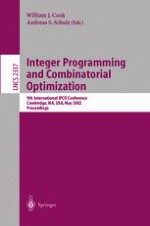2002 | OriginalPaper | Buchkapitel
Building Edge-Failure Resilient Networks
verfasst von : Chandra Chekuri, Anupam Gupta, Amit Kumar, Joseph (Seffi) Naor, Danny Raz
Erschienen in: Integer Programming and Combinatorial Optimization
Verlag: Springer Berlin Heidelberg
Enthalten in: Professional Book Archive
Aktivieren Sie unsere intelligente Suche, um passende Fachinhalte oder Patente zu finden.
Wählen Sie Textabschnitte aus um mit Künstlicher Intelligenz passenden Patente zu finden. powered by
Markieren Sie Textabschnitte, um KI-gestützt weitere passende Inhalte zu finden. powered by
We consider the design of resilient networks that are fault tolerant against single link failures. Resilience against single link failures can be built into the network by providing backup paths, which are used when an edge failure occurs on a primary path. We consider several network design problems in this context: the goal is to provision primary and backup bandwidth while minimizing cost. Our models are motivated by current high speed optical networks and we provide approximation algorithms for the problems below.The main problem we consider is that of backup allocation. In this problem, we are given an already provisioned (primary) network, and we want to reserve backup capacity on the edges of the underlying network so that all the demand can be routed even in the case of a single edge failure. We also consider a variant where the primary network has a tree topology and it is required that the restored network retains the tree topology. We then address the problem of simultaneous primary and backup allocation, in which we are given specifications of the traffic to be handled, and we want to both provision the primary as well as the backup network. We also investigate the online model where the primary network is not known in advance. Demands between source-sink pairs arrive online and the goal is to provide a primary path and set of backup edges that can be used for restoring a failure of any of the primary edges.
